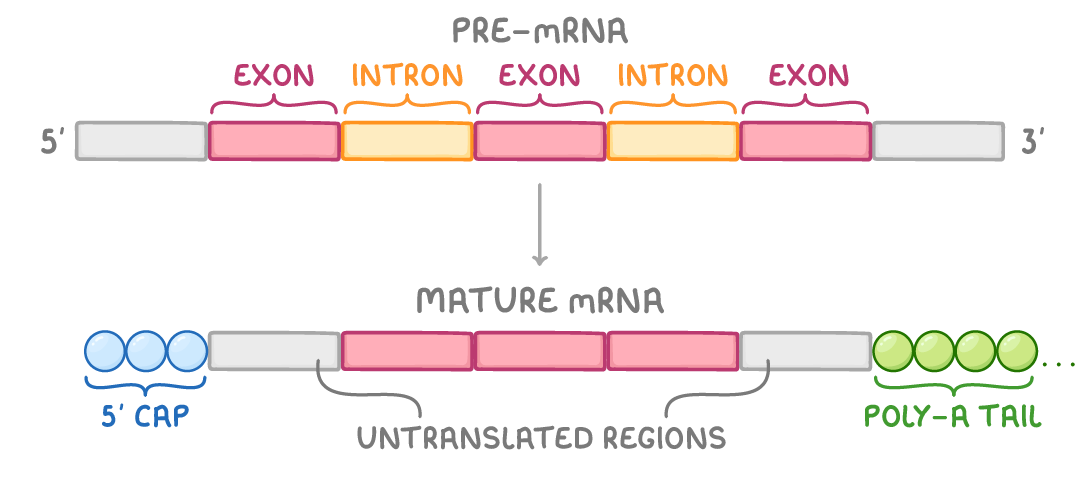Post-transcriptional Control
This lesson covers:
- RNA processing to produce mature mRNA
- Mechanisms of translational control
- The role of protein kinases in post-translational modification
- Types of post-translational protein modification
RNA processing
The initial transcript produced by transcription is precursor mRNA (pre-mRNA), which must be processed before it can be translated into proteins.
Introns, the non-coding regions of DNA, are transcribed but then removed from the pre-mRNA. Exons, the coding regions, are joined together to form mature mRNA, ready for translation.

Pre-mRNA is processed by:
- Addition of a 5’ cap - This stabilises the mRNA, delays its degradation, and assists in ribosome binding.
- Addition of a 3’ poly-A tail - This stabilises the mRNA and delays its degradation.
- Splicing - Introns are removed and exons are joined together, providing the instructions for the protein sequence.
RNA editing further modifies mRNA nucleotides through substitution, addition, or deletion of bases. This can alter the protein product in a manner similar to point mutations, so many different proteins can be synthesised from a single mRNA molecule.
Translational control
The rate at which translation occurs can be finely regulated to control the levels of protein produced.
Factors that affect the rate of translation
- mRNA degradation rates:
- mRNA that degrades slowly is more stable and lasts longer.
- This can increase translation and protein synthesis.
- Inhibitory proteins:
- These can bind to mRNA, preventing it from attaching to ribosomes.
- This decreases translation and protein synthesis.
- Initiation factors:
- Activated initiation factors help mRNA bind to ribosomes.
- This initiates translation and increases protein synthesis.
- For instance, after fertilisation, initiation factors are activated, allowing the translation of stored maternal mRNAs.
Protein kinases
Protein kinases are a type of enzyme that can control many aspects of cellular activity, including protein modification.
They do this as follows:
- Protein kinases add phosphate groups to proteins through phosphorylation.
- Phosphorylation changes the protein's tertiary structure and function.
- This often activates enzymes.
- The activity of protein kinases can be regulated by cyclic AMP (cAMP).
Post-translational modification
After synthesis, proteins can undergo post-translational modifications, which influence their function.
Examples of these modifications include:
- The addition of carbohydrates, lipids, or phosphate groups.
- The formation of disulfide bridges between amino acids.
- The shortening of peptide chains.
- Folding into specific 3D shapes.
- Modification by cAMP, as seen in the lac operon.
These modifications significantly increase the diversity of proteins that can be produced from a single mRNA molecule.
Through post-transcriptional and post-translational controls, cells can finely regulate gene expression after transcription, ensuring proteins are produced at the right time and in the right amounts.